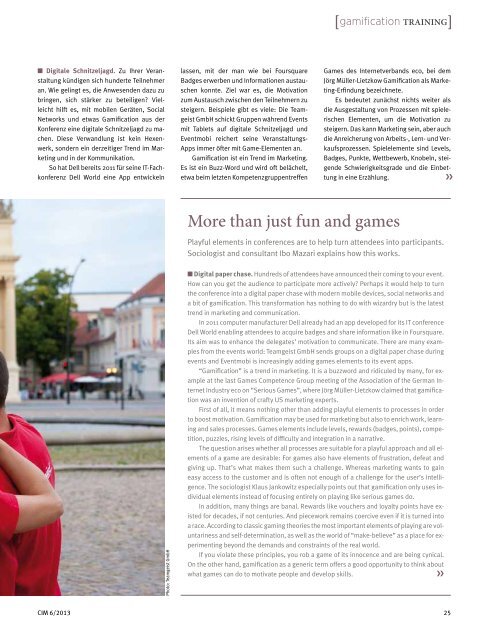Destination - CIM
Destination - CIM
Destination - CIM
Erfolgreiche ePaper selbst erstellen
Machen Sie aus Ihren PDF Publikationen ein blätterbares Flipbook mit unserer einzigartigen Google optimierten e-Paper Software.
[gamification Training]n Digitale Schnitzeljagd. Zu Ihrer Veranstaltungkündigen sich hunderte Teilnehmeran. Wie gelingt es, die Anwesenden dazu zubringen, sich stärker zu beteiligen? Vielleichthilft es, mit mobilen Geräten, SocialNetworks und etwas Gamification aus derKonferenz eine digitale Schnitzeljagd zu machen.Diese Verwandlung ist kein Hexenwerk,sondern ein derzeitiger Trend im Marketingund in der Kommunikation.So hat Dell bereits 2011 für seine IT-FachkonferenzDell World eine App entwickelnlassen, mit der man wie bei FoursquareBadges erwerben und Informationen austauschenkonnte. Ziel war es, die Motivationzum Austausch zwischen den Teilnehmern zusteigern. Beispiele gibt es viele: Die TeamgeistGmbH schickt Gruppen während Eventsmit Tablets auf digitale Schnitzeljagd undEventmobi reichert seine Veranstaltungs-Apps immer öfter mit Game-Elementen an.Gamification ist ein Trend im Marketing.Es ist ein Buzz-Word und wird oft belächelt,etwa beim letzten KompetenzgruppentreffenGames des Internetverbands eco, bei demJörg Müller-Lietzkow Gamification als Marketing-Erfindungbezeichnete.Es bedeutet zunächst nichts weiter alsdie Ausgestaltung von Prozessen mit spielerischenElementen, um die Motivation zusteigern. Das kann Marketing sein, aber auchdie Anreicherung von Arbeits-, Lern- und Verkaufsprozessen.Spielelemente sind Levels,Badges, Punkte, Wettbewerb, Knobeln, steigendeSchwierigkeitsgrade und die Einbettungin eine Erzählung.More than just fun and gamesPlayful elements in conferences are to help turn attendees into participants.Sociologist and consultant Ibo Mazari explains how this works.Photo: Teamgeist GmbHn Digital paper chase. Hundreds of attendees have announced their coming to your event.How can you get the audience to participate more actively? Perhaps it would help to turnthe conference into a digital paper chase with modern mobile devices, social networks anda bit of gamification. This transformation has nothing to do with wizardry but is the latesttrend in marketing and communication.In 2011 computer manufacturer Dell already had an app developed for its IT conferenceDell World enabling attendees to acquire badges and share information like in Foursquare.Its aim was to enhance the delegates’ motivation to communicate. There are many examplesfrom the events world: Teamgeist GmbH sends groups on a digital paper chase duringevents and Eventmobi is increasingly adding games elements to its event apps.“Gamification” is a trend in marketing. It is a buzzword and ridiculed by many, for exampleat the last Games Competence Group meeting of the Association of the German InternetIndustry eco on “Serious Games”, where Jörg Müller-Lietzkow claimed that gamificationwas an invention of crafty US marketing experts.First of all, it means nothing other than adding playful elements to processes in orderto boost motivation. Gamification may be used for marketing but also to enrich work, learningand sales processes. Games elements include levels, rewards (badges, points), competition,puzzles, rising levels of difficulty and integration in a narrative.The question arises whether all processes are suitable for a playful approach and all elementsof a game are desirable: For games also have elements of frustration, defeat andgiving up. That’s what makes them such a challenge. Whereas marketing wants to gaineasy access to the customer and is often not enough of a challenge for the user’s intelligence.The sociologist Klaus Jankowitz especially points out that gamification only uses individualelements instead of focusing entirely on playing like serious games do.In addition, many things are banal. Rewards like vouchers and loyalty points have existedfor decades, if not centuries. And piecework remains coercive even if it is turned intoa race. According to classic gaming theories the most important elements of playing are voluntarinessand self-determination, as well as the world of “make-believe” as a place for experimentingbeyond the demands and constraints of the real world.If you violate these principles, you rob a game of its innocence and are being cynical.On the other hand, gamification as a generic term offers a good opportunity to think aboutwhat games can do to motivate people and develop skills.<strong>CIM</strong> 6/201325





